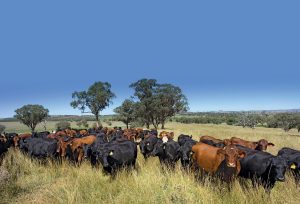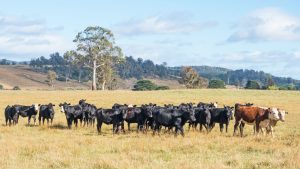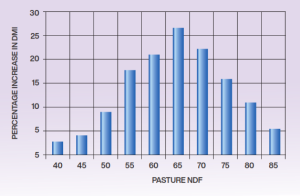Other news items
Find more interesting articles below.

Consistent, above average rainfall and mild conditions have promoted excellent pasture growth in many regions across Australia over the past 2-3 years. These conditions have resulted in greater pasture growth and less seasonal fluctuation in pasture availability.
Although the quantity of pasture grown may have increased, continued rainfall events have led to the leaching of nutrients, particularly water-soluble carbohydrates (sugars) and protein from the plant material. This accelerated nutrient loss can be deceptive as a large volume of pasture may be present, and a proportion actively growing, but the total energy density will be greatly reduced.
In addition, as plants grow and mature toward flowering and setting seed, changes occur in the ratio of stem to leaf as well as the structure of the plant cells which reduce the energy and protein content and reduce digestibility.
Whilst there may be a large amount of pasture in the paddock, we need to be conscious of the stage of plant growth, the amount of nutrients and the impacts that has for animals grazing them.
As a plant matures, readily digestible components of the plant cells (protein, lipids, sugars, starch and organic acids) decline, and the less digestible cell wall constituents (cellulose and hemicellulose) increase in size and become bound together by a process called lignification. Cellulose and hemicellulose are partially digested by fermentation in the rumen. Lignin formed in the plant cell wall is indigestible by ruminants.
The total proportion of cellulose, hemicellulose and lignin in pasture can be measured using the “detergent fibre system”. This process dissolves the proportions of plant cells, allowing them to be classed as Neutral Detergent Fibre (NDF) or Acid Detergent Fibre (ADF). NDF is a measure of cellulose, hemicellulose and lignin, whilst ADF is a measure of cellulose and lignin. Any feed test of pasture will report on NDF and ADF of the feed. Higher pasture NDF values mean that there are less readily digestible components in the feed and there is more cellulose and hemicellulose to ferment.
This has the following effects on animal intake:
Although a large volume of pasture is available in many regions, we are now faced with the challenge that it is matured or maturing, with reduced levels of nutrients due to leaching, less digestible components and a high NDF restricting intake.
So, the question remains:
When looking to utilise a standing body of mature pasture it is important to understand the composition of the feed and determine if animals are physically able to consume enough feed to meet their requirements, and if not, how best to supplement them to meet their requirements.

Performance Feeds has conducted a broadscale survey of mature pastures across Australia to understand the quality of the large volume of mature feed many producers are dealing with.
Average figures from the tests conducted have provided the following results:
Pasture Availability: 4000kg Dry matter/ha
Metabolisable energy: 7 MJ ME/kg DM
Crude Protein: 7%
NDF: 65 %
Digestibility: 50%
Grazing: 550kg in last 3 months of gestation
Aim: Gain 0.4kg/d calves at foot
ME requirement: 85 MJ/day
Protein requirement: 750 grams/day
Based on the NDF content of the pasture animals can eat 1.84% of their bodyweight or 10kg/day. At 7MJ/kg this is 71 MJ/day and 710 grams of protein. This means animals are in a deficit of 14 MJ ME and 40 grams of protein per day.
Anipro intake 125ml/100kg liveweight: 688ml/day
Predicted pasture intake with Anipro: 12.9kg/day
Predicted ME intake: 90 MJ/day
Predicted protein intake: 902 (Pasture) + 78 (Anipro) = 980 grams
Grazing: 300kg weaner steers
Aim: Gain 0.25kg/day
ME requirement: 49 MJ/day
Protein requirement: 550 grams/day
Based on the NDF content of the pasture animals can eat 1.84% of their bodyweight or 5kg . At 7MJ/kg this is 39 MJ/day and 388 grams of protein. This means animals are in a deficit of 10 MJ and 162 grams of protein per day.
Anipro intake 125ml/100kg liveweight: 375ml/day
Predicted pasture intake with Anipro: 7kg/day
Predicted ME intake: 49 MJ/day
Predicted protein intake: 492 (Pasture)+ 43 (Anipro)= 535 grams
At 65% NDF, Anipro will increase fibre digestibility and allow a 27% increase in dry matter intake. With 20% (balancer) and 15% (starter) crude protein levels, Anipro also provides additional protein to support animal requirements.
Anipro promotes greater intake of mature, leached pasture with poor nutrient levels, and allows animals to consume greater energy and protein levels without additional supplementary feed. This
can reduce the gap between animals requirement and their intake, leading to improved performance of cattle.
The extent of the effect will depend on the NDF content of the pasture in question and the consumption of Anipro. Poor pasture quality will drive higher Anipro intakes which will in turn promote greater pasture (and thus energy intake). Anipro intakes are managed using the appropriate level of Anipro balancer ration.

Find more interesting articles below.
Drop the Performance Feeds team a message and we will be back in touch.